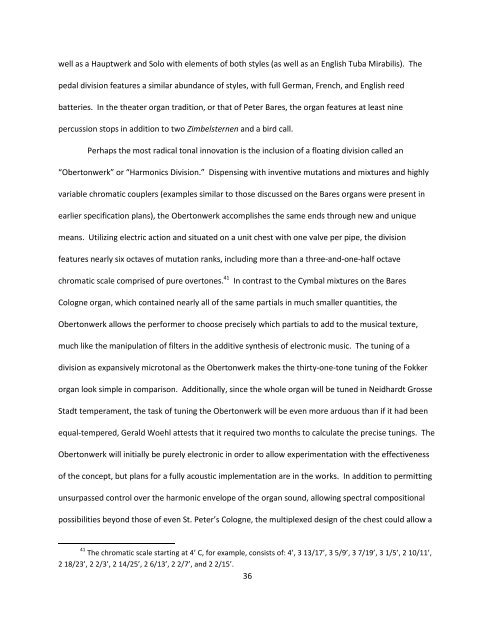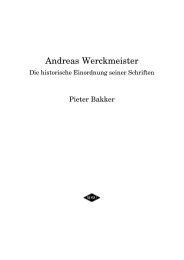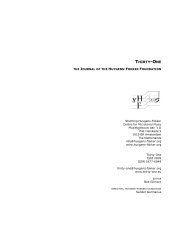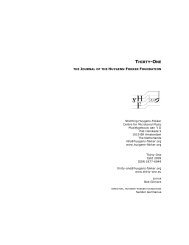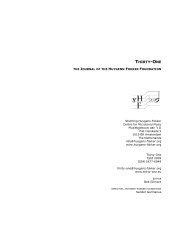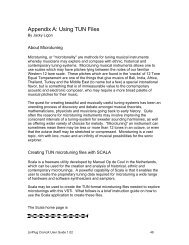Recent Organ Design Innovations and the 21st-century - Stichting ...
Recent Organ Design Innovations and the 21st-century - Stichting ...
Recent Organ Design Innovations and the 21st-century - Stichting ...
Create successful ePaper yourself
Turn your PDF publications into a flip-book with our unique Google optimized e-Paper software.
well as a Hauptwerk <strong>and</strong> Solo with elements of both styles (as well as an English Tuba Mirabilis). The<br />
pedal division features a similar abundance of styles, with full German, French, <strong>and</strong> English reed<br />
batteries. In <strong>the</strong> <strong>the</strong>ater organ tradition, or that of Peter Bares, <strong>the</strong> organ features at least nine<br />
percussion stops in addition to two Zimbelsternen <strong>and</strong> a bird call.<br />
Perhaps <strong>the</strong> most radical tonal innovation is <strong>the</strong> inclusion of a floating division called an<br />
“Obertonwerk” or “Harmonics Division.” Dispensing with inventive mutations <strong>and</strong> mixtures <strong>and</strong> highly<br />
variable chromatic couplers (examples similar to those discussed on <strong>the</strong> Bares organs were present in<br />
earlier specification plans), <strong>the</strong> Obertonwerk accomplishes <strong>the</strong> same ends through new <strong>and</strong> unique<br />
means. Utilizing electric action <strong>and</strong> situated on a unit chest with one valve per pipe, <strong>the</strong> division<br />
features nearly six octaves of mutation ranks, including more than a three-<strong>and</strong>-one-half octave<br />
chromatic scale comprised of pure overtones. 41 In contrast to <strong>the</strong> Cymbal mixtures on <strong>the</strong> Bares<br />
Cologne organ, which contained nearly all of <strong>the</strong> same partials in much smaller quantities, <strong>the</strong><br />
Obertonwerk allows <strong>the</strong> performer to choose precisely which partials to add to <strong>the</strong> musical texture,<br />
much like <strong>the</strong> manipulation of filters in <strong>the</strong> additive syn<strong>the</strong>sis of electronic music. The tuning of a<br />
division as expansively microtonal as <strong>the</strong> Obertonwerk makes <strong>the</strong> thirty-one-tone tuning of <strong>the</strong> Fokker<br />
organ look simple in comparison. Additionally, since <strong>the</strong> whole organ will be tuned in Neidhardt Grosse<br />
Stadt temperament, <strong>the</strong> task of tuning <strong>the</strong> Obertonwerk will be even more arduous than if it had been<br />
equal-tempered, Gerald Woehl attests that it required two months to calculate <strong>the</strong> precise tunings. The<br />
Obertonwerk will initially be purely electronic in order to allow experimentation with <strong>the</strong> effectiveness<br />
of <strong>the</strong> concept, but plans for a fully acoustic implementation are in <strong>the</strong> works. In addition to permitting<br />
unsurpassed control over <strong>the</strong> harmonic envelope of <strong>the</strong> organ sound, allowing spectral compositional<br />
possibilities beyond those of even St. Peter’s Cologne, <strong>the</strong> multiplexed design of <strong>the</strong> chest could allow a<br />
41 The chromatic scale starting at 4’ C, for example, consists of: 4’, 3 13/17’, 3 5/9’, 3 7/19’, 3 1/5’, 2 10/11’,<br />
2 18/23’, 2 2/3’, 2 14/25’, 2 6/13’, 2 2/7’, <strong>and</strong> 2 2/15’.<br />
36


